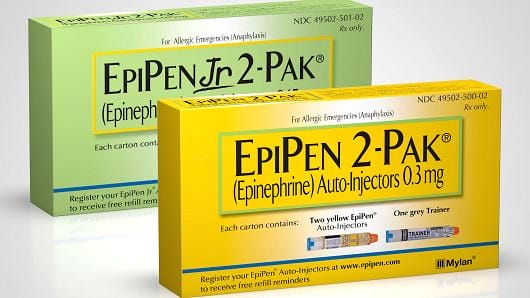
Illinois has become the largest of a list of states to cap the price of epinephrine auto-injectors. The state’s new epinephrine price cap law says insurers can’t charge more than $60 for a set of two auto-injectors for patients 18 and under.
The U.S. food allergy community is lauding the decisions of Illinois and other states to limit what patients must pay for epinephrine. But Allergic Living decided to dig deeper. In this article, we investigate: who pays such price limit differences, how high have deductibles on epinephrine become, and how will insurers respond? As well, we get responses from key epinephrine device makers.
As anyone living with anaphylaxis risk knows, epinephrine is the first-line defense in a severe reaction. “It is critically important that we do everything possible to ensure that the working poor and middle-class families can afford lifesaving medicine for their children,” says Jason Linde. He is senior vice president for advocacy for the nonprofit Food Allergy Research and Education (FARE).
Laws like the Illinois epinephrine price cap are a step in the right direction in expanding accessibility, says Kaléo chief commercial officer Alfred Tenuto. Kaléo is the developer of the Auvi-Q epinephrine auto-injector known for its voice-guided instruction.
“Anything that gives the patient the opportunity to carry their epinephrine auto-injector is positive,” says Tenuto, whose brand also introduced pricing relief measures.
The Illinois law takes aim at out-of-pocket costs that can top $600 for the market-leading EpiPen auto-injector at retail. It requires insurers to limit the cost, “regardless of the type of epinephrine injector,” according to the state legislation.
Governor J.B. Pritzker signed Illinois House Bill 3639 into law in August 2023, and it takes effect in January 2025.
High Cost of Epinephrine
The furor over epinephrine retail pricing first bubbled over in 2016. At that time, the price of a set of two EpiPen auto-injectors soared from approximately $100 to over $600. Mylan NV (now Viatris) came under fire for raising the price by about 500 percent after acquiring the auto-injector’s marketing rights in 2007.
Families reported sticker shock at pharmacy counters, then a congressional committee in 2016 grilled Mylan’s former CEO Heather Bresch. The questioning over the price hike dominated the news, and the EpiPen became a widely cited example of high drug costs.
Today, allergic patients have more epinephrine options with a range of generic auto-injectors and other brands, such as Auvi-Q. However, cost remains a factor for patient access. Type of insurance, the form of auto-injector allowed under a patient’s plan, along with co-pay or deductible amount, all affect what a consumer pays.
Reflecting the concerns over auto-injector access, a July 2022 study examined out-of-pocket spending on epinephrine auto-injectors by privately insured patients. Between 2015 and 2019, the study found 1 in 13 patients were paying more than $200 a year for auto-injectors. Among those families, 62.5 percent were enrolled in high-deductible health plans.
“There are two primary factors that contribute to high out-of-pocket costs for epinephrine auto-injectors: their high price, and the inadequate protection from these prices in insurance plans,” says study leader Dr. Kao-Ping Chua of the University of Michigan.
KFF, the nonprofit health policy organization, reports that 32 percent of Americans with employer-sponsored insurance had an annual deductible of $2,000 or more in 2022. That’s an increase from 7 percent in 2009. With a deductible that high, families could potentially pay for multiple sets of two before insurance kicks in.
High drug prices can even deter families from filling much-needed prescriptions. In 2021, 6 percent of U.S. adults rationed medication. Meanwhile, 5 percent reported not getting medication at all due to cost, according to a Peterson-KFF Health System Tracker study.
“Caps on out-of-pocket costs help people who face issues affording their medications,” says Krutika Amin, PhD, who co-authored the study.
Epi Price Caps: What Insurers are Doing
Under state laws like the Illinois bill, private health insurance plans will pick up more of the tab, says Amin, associate director of KFF’s program on the Affordable Care Act.
Manufacturers don’t change the price of their drugs because of price caps, explains Amin, who is associate director of the Peterson-KFF Health System Tracker project.
That could mean that health insurers will increase premiums to cover the additional costs, she says. However, if the result of more people having epinephrine auto-injectors means fewer end up in the emergency room, significant other costs can be offset, she says.

Fewer hospital admissions are among the factors driving one health insurance provider to act on its own to improve accessibility. As of January 2023, United Healthcare eliminated out-of-pocket costs for epinephrine and other drugs, including insulin and albuterol, under certain plans.
The move is an effort to “help reduce the burden of medical costs on consumers and encourage better medication adherence, reducing the risk of complications and expensive hospitalizations,” says the company.
Back in Illinois, the Illinois Life & Health Insurance Council worked with lawmakers on the state epinephrine bill. “The rising cost of prescription drugs is undoubtedly front of mind for patients who depend on these drugs,” says Kate Morthland, the council’s director of policy and advocacy.
But she notes that with such a cap, the issue of underlying cost for health insurance and health care remains. Laws like this are likely to result in overall premium increases to cover the cost, according to Morthland.
Price Caps Laws: Stopgap Measures
Also, in Illinois, while insurance plans regulated by the state will follow the epinephrine price cap, federally regulated plans are not affected.
“Insurers play an important role in managing these increasing costs for the consumer and employers,” Morthland says. “But they also represent only one entity within the larger drug supply chain.”
“These laws are best seen as stopgap measures,” cautions Chua, the health policy researcher at the University of Michigan Medical School in Ann Arbor. He also notes that the Illinois legislation does not address the underlying factors driving high out-of-pocket costs. Nor does it help all patients.
But the legislation is beneficial for the group of patients who are paying high out-of-pocket costs, largely because of high deductibles. Chua tells Allergic Living that the epinephrine price cap will allow more patients to afford and to fill prescriptions for lifesaving auto-injectors.
But could more auto-injector purchases lead to supply issues? On that, Chua isn’t concerned. “I would not expect this increase to exacerbate shortages because these patients are relatively few in number.”
What Do Epi Makers Think?
As lawmakers and advocates work to find solutions to high epinephrine costs, pharmaceutical companies work to ensure their products are accessible.
“It is vitally important that epinephrine auto-injectors with innovative features, like Auvi-Q, should be available to patients without high co-pays, deductibles, co-insurance, or burdensome prior authorizations,” says Caryn Foster Durham, Kaléo’s senior director of corporate communications.
Kaléo has been working with insurance companies and pharmacy benefits managers to broaden its coverage, Tenuto says. Some insurance plans cover Auvi-Q for a $35 co-pay.
For patients with insurance that does not cover Auvi-Q or with a high-deductible plan, Kaléo works to provide a set of two devices at no more than $150. Tenuto says many of the patients they help are those who face price pressure because they are under-insured. With high costs for Auvi-Q to manufacture and distribute, he says $150 is the lowest the company can go.
The price cap law does not affect the brand’s costs, as the cap shifts cost to the insurers. “This type of law is great because it makes all of the insured patients on the same playing field,” Tenuto says.
His one fear is that insurers might choose to limit options. For instance, only offering the cheapest available auto-injector under an epinephrine price cap law. “As long as the law doesn’t have the unintended consequence of limiting options for insured patients, we see it as a positive,” Tenuto says.
EpiPen maker Viatris, did not respond to requests for comment. The company offers EpiPen savings cards available to offset out-of-pocket costs.
ARS Pharmaceuticals, which has developed a new epinephrine nasal spray called neffy, is awaiting the FDA’s decision on approval. Meantime, the company is collaborating with insurers, pharmacy benefit managers and pharmacies so that it can make the new option widely available if approved, says an ARS spokesperson.
The nasal spray device maker also views price cap laws as a positive step. “The efforts speak to the urgency of making epinephrine more accessible, and more likely to be used, in the case of a severe allergic reaction,” the spokesperson told Allergic Living.
Legislative Efforts Across the U.S.
Illinois lawmakers are not alone in their efforts to cap epinephrine prices. In July 2023, Colorado Governor Jared Polis signed a bill capping the price of sets of two auto-injectors at $60 for insured patients. The Colorado law includes a program that would offer auto-injectors for $60 for qualified state residents who don’t have insurance.
Following is a look at new state laws or bills in progress that aim to make epinephrine auto-injectors affordable.
- Colorado: House Bill 23-1002. Price cap: $60 per set of two. Signed: July 2023, took effect: January 2024.
- Delaware: House Bill 54. Expands previous bill to include all ages. Insurance carriers must offer at least one option of epinephrine auto-injector on its lowest cost tier of approved medications. Signed: May 2023, took effect: January 2024.
- Minnesota: Senate File 2744. Price cap: $50. Signed: May 2023, takes effect: January 2025.
- Missouri: House Bill 342. Price cap: $100 per 30-day supply. Introduced: January 2023, has not moved forward.
- New Hampshire: House Bill 1280. Requires insurers to fully cover epinephrine auto-injectors. Signed: July 2020, took effect: January 2021.
- New Jersey. Senate No. 1614. Price cap: $25 per 30-day supply. Signed: July 2023, takes effect: early 2025.
- Rhode Island: Senate 0575A, House 5176A. Insurers must fully cover at least one auto-injector set of two per year. Signed: June 2023, takes effect: January 2025.
- Vermont. House 11. Would require insurers to fully cover epinephrine auto-injectors. Introduced: January 2023, at committee stage.
FARE’s Linde is hopeful that other states will follow the lead of these lawmakers. “Because epinephrine is medicine that is absolutely essential to protecting the lives of the more than 33 million Americans with food allergies, we strongly encourage all states to act and pass similar laws,” he says.
Article updated: March 2024
Related Reading:
All About Epinephrine: What It Does in a Reaction, How Long It Lasts, When It Gets Hot or Cold
Schools and Locked Up Epinephrine: A Dangerous Situation
Pfizer Agrees to Pay $345M to Settle EpiPen Price Hike Case





